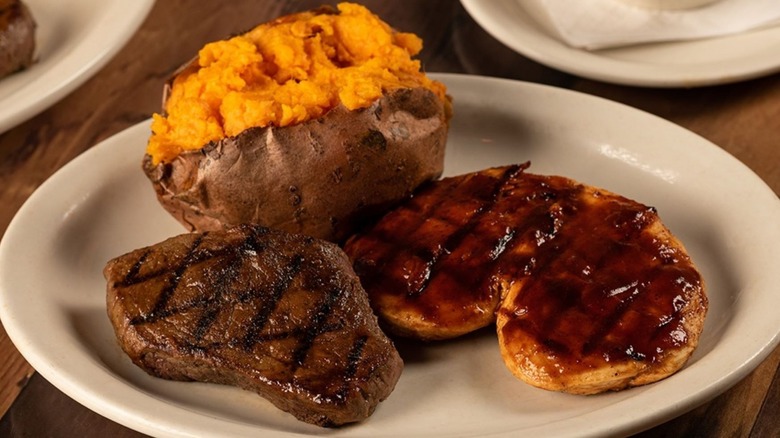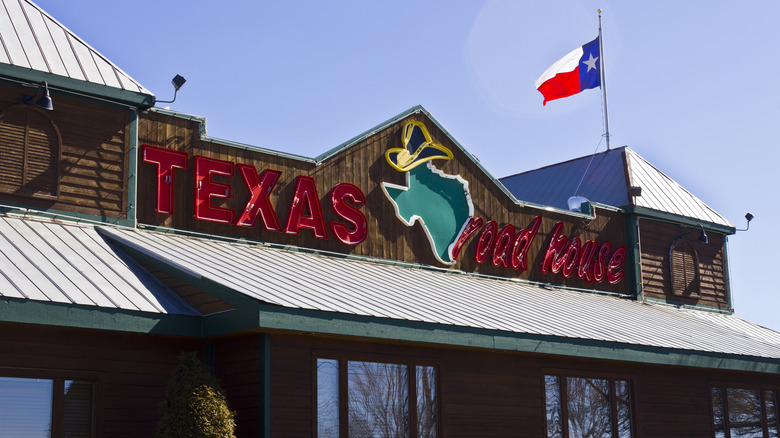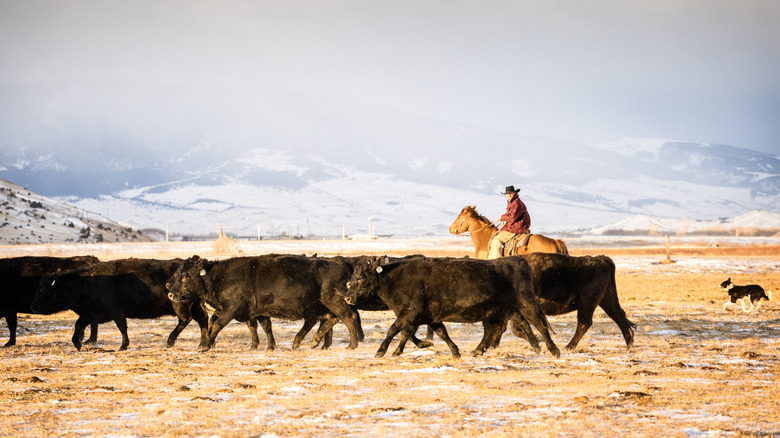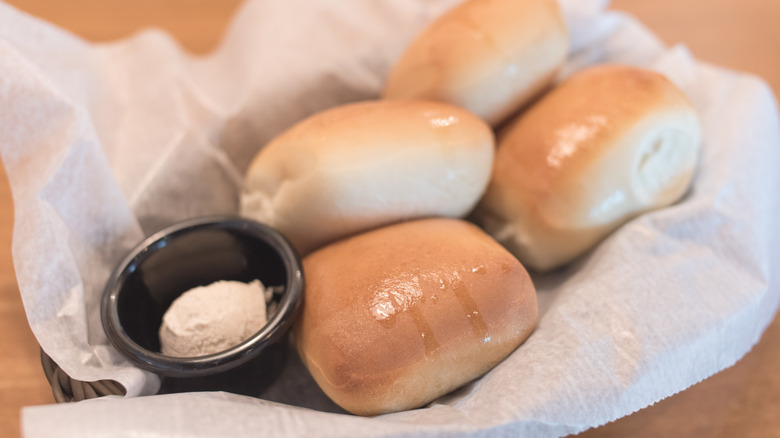Texas Roadhouse Is Raising Its Prices For The Third Time In Under A Year
The Instagram bio of Texas Roadhouse's official social media account promises "Legendary Food, Legendary Service." It does not, however, promise legendary value. Texas Roadhouse raised its prices by 2.7% last October. Now, the chain is already gearing up to do it again, making this the third price increase in less than a year. (We love the Cactus Blossom as much as the next foodie, but this is getting a little ridiculous.)
This time, menu prices are slated to increase by 2.2%, which could occur sometime near the end of March 2024. Considering the 2.2% menu price hike in April 2023, Texas Roadhouse will be 7.1% more expensive in April 2024 compared to just one year prior. A fourth price hike doesn't seem to be outside of the realm of possibility, either. During an earnings call with investors on February 15, Texas Roadhouse CFO Chris Monroe explained that this third menu price increase is all about combating inflation.
Monroe also cited other economic stressors like state-mandated minimum wage increases (a growing national trend and a huge victory for low-wage workers in America), competitor restaurant prices, and consumer traffic patterns. Raking in a little extra money per tater skin or sirloin steak, says Monroe, will help offset the effects of inflation on the steakhouse. (Inflation-weary customers, meanwhile, might wonder when their reprieve is coming.) Although, notably, these supposed motivators for the menu price hike haven't seemed to slow the company's growth any.
Relying on customers' wallets to defend the bottom line
Fiscal Q4 saw better-than-expected same-store sales (9.9% over a projected 8.5%), and Texas Roadhouse demonstrated year-over-year revenue growth of 15.36% from Q4 2022 to Q4 2023 with a gross profit margin of 15.8%. Shares are also up 40% over the past 12 months, and after the February 15 earnings call, stock rose 10% to $147.15 in morning trading. The chain also expects cattle inflation prices to cool a little this year, which means lower operating costs.
Perhaps this will ease some pricing pressures as the chain continues expanding, which has also increased costs. Texas Roadhouse even opened its largest-ever restaurant in early 2023, which boasts 12,000 square feet. Wendy's caught backlash for becoming the most expensive fast food chain in 2022 following a series of price hikes that made the menu 35% more expensive than in 2021. Admittedly, a 7.1% price increase might not be a hugely perceptible leap for a sit-down restaurant like Texas Roadhouse. The same steak dinner that might have cost you $40 last year will now set you back $42.84.
Still, this consistent price raising is representative of a larger economic crisis. Inflation shot up to record heights in recent years. While it isn't increasing as intensely as it once was, it's staying put at a high and unaffordable level. Now, as state legislatures are stepping in to secure higher wages for workers, the businesses who sign those workers' paychecks could cite this as another reason to drive menu prices higher and higher.
Drought has been causing beef prices to skyrocket
Despite Texas Roadhouse's optimistic outlook for beef prices in the coming year, the cost of steak saw a big jump in 2023 and is expected to remain high for a while, mostly thanks to a multi-year drought in cattle ranching states like Texas and Kansas. A report from the Bureau of Labor Statistics shows that beef prices jumped 7.7% last year, while the price of steaks was up almost 11%. The average retail price of beef has been hovering around $8 a pound – almost 25% more than the pre-pandemic average.
While prices at restaurants are always a complicated mix of labor costs, food costs, and the company's own profit goals, the recent droughts have been pretty severe and are clearly having an effect. Up until late last year, much of the nation's cattle country had been in severe or higher drought. That doesn't just mean cattle grow slower with less feed, but ranchers will also slaughter breeding cattle to cover the loss of other cows, which hurts their ability to regrow the depleted stock and leads to an extended period of higher prices.
The same extreme drought has also driven down the hay harvests used to fatten up cattle. According to the American Farm Bureau Federation, the current cattle stocks are the lowest they have been since 1951, while feed stocks are the lowest since 1954. Thankfully, a rainy last few months have slightly eased the drought, but the effects are likely to linger all year.
Texas Roadhouse still has the budget advantage over its competitors
While a 7% price increase in just a year isn't fun for consumers looking for relief anywhere they can, Texas Roadhouse is still frequently the cheapest option for people who want a steak at a sit-down restaurant. Prices are well below its biggest competitor in the casual steakhouse category, Outback Steakhouse, and its steaks are still a few bucks cheaper than third-place competitor Longhorn Steakhouse as well. While the string of price increases could cut into this advantage, most of its rivals have also increased prices in the last few years.
Maintaining a cost advantage on steak is a core part of the chain's business model, as the company deliberately prices its beef as a loss leader to draw customers into the restaurant for high-margin Texas Roadhouse menu items like sides and alcohol. Texas Roadhouse also keeps its menu static and simple and strategically places its retail locations in lower-traffic areas with cheaper rent to help keep its costs down.
Despite the price increase, Texas Roadhouse could actually be the beneficiary of more cost-conscious consumers. The steakhouse's strong growth last year went against the industry trend, and it could be benefiting from people "trading down" from more expensive options like Outback. Its sales growth came not just from higher prices, but a 5.1% increase in traffic, suggesting that higher prices aren't keeping people away. This latest price bump may finally break the camel's back, but so far, Texas Roadhouse's history suggests otherwise.



